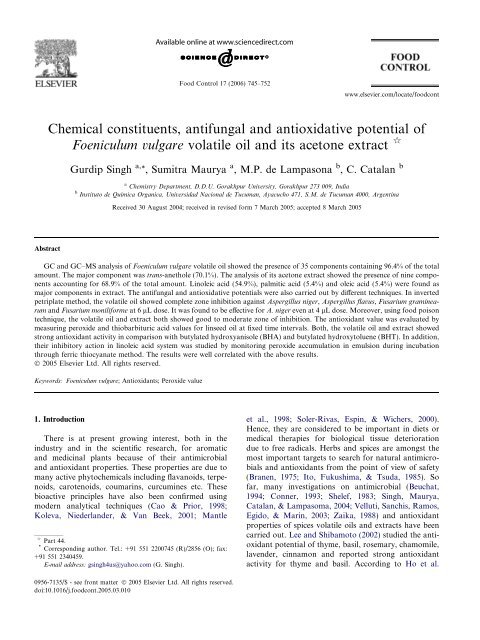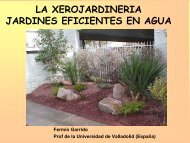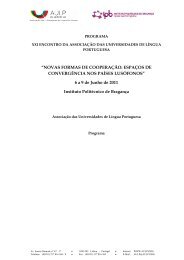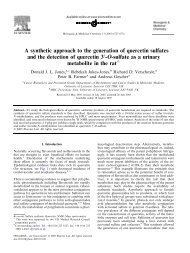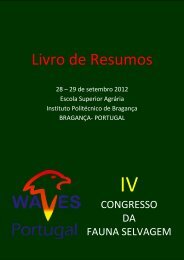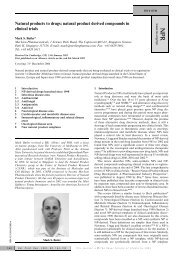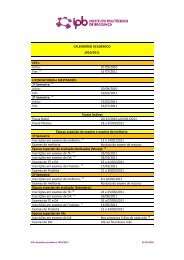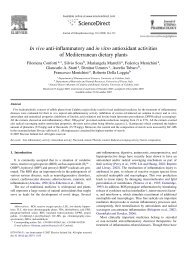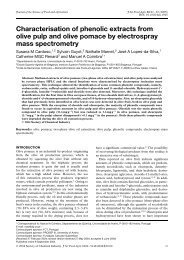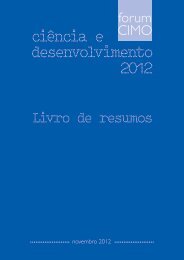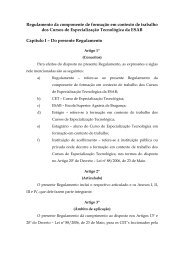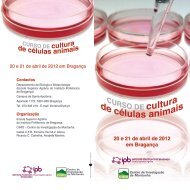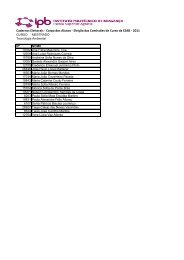Foeniculum vulgare - ESA
Foeniculum vulgare - ESA
Foeniculum vulgare - ESA
Create successful ePaper yourself
Turn your PDF publications into a flip-book with our unique Google optimized e-Paper software.
Chemical constituents, antifungal and antioxidative potential of<br />
<strong>Foeniculum</strong> <strong>vulgare</strong> volatile oil and its acetone extract q<br />
Abstract<br />
Gurdip Singh a, *, Sumitra Maurya a , M.P. de Lampasona b , C. Catalan b<br />
a Chemistry Department, D.D.U. Gorakhpur University, Gorakhpur 273 009, India<br />
b Instituto de Quimica Organica, Universidad Nacional de Tucuman, Ayacucho 471, S.M. de Tucuman 4000, Argentina<br />
Received 30 August 2004; received in revised form 7 March 2005; accepted 8 March 2005<br />
GC and GC–MS analysis of <strong>Foeniculum</strong> <strong>vulgare</strong> volatile oil showed the presence of 35 components containing 96.4% of the total<br />
amount. The major component was trans-anethole (70.1%). The analysis of its acetone extract showed the presence of nine components<br />
accounting for 68.9% of the total amount. Linoleic acid (54.9%), palmitic acid (5.4%) and oleic acid (5.4%) were found as<br />
major components in extract. The antifungal and antioxidative potentials were also carried out by different techniques. In inverted<br />
petriplate method, the volatile oil showed complete zone inhibition against Aspergillus niger, Aspergillus flavus, Fusarium graminearum<br />
and Fusarium moniliforme at 6 lL dose. It was found to be effective for A. niger even at 4 lL dose. Moreover, using food poison<br />
technique, the volatile oil and extract both showed good to moderate zone of inhibition. The antioxidant value was evaluated by<br />
measuring peroxide and thiobarbituric acid values for linseed oil at fixed time intervals. Both, the volatile oil and extract showed<br />
strong antioxidant activity in comparison with butylated hydroxyanisole (BHA) and butylated hydroxytoluene (BHT). In addition,<br />
their inhibitory action in linoleic acid system was studied by monitoring peroxide accumulation in emulsion during incubation<br />
through ferric thiocyanate method. The results were well correlated with the above results.<br />
Ó 2005 Elsevier Ltd. All rights reserved.<br />
Keywords: <strong>Foeniculum</strong> <strong>vulgare</strong>; Antioxidants; Peroxide value<br />
1. Introduction<br />
There is at present growing interest, both in the<br />
industry and in the scientific research, for aromatic<br />
and medicinal plants because of their antimicrobial<br />
and antioxidant properties. These properties are due to<br />
many active phytochemicals including flavanoids, terpenoids,<br />
carotenoids, coumarins, curcumines etc. These<br />
bioactive principles have also been confirmed using<br />
modern analytical techniques (Cao & Prior, 1998;<br />
Koleva, Niederlander, & Van Beek, 2001; Mantle<br />
q Part 44.<br />
* Corresponding author. Tel.: +91 551 2200745 (R)/2856 (O); fax:<br />
+91 551 2340459.<br />
E-mail address: gsingh4us@yahoo.com (G. Singh).<br />
Food Control 17 (2006) 745–752<br />
0956-7135/$ - see front matter Ó 2005 Elsevier Ltd. All rights reserved.<br />
doi:10.1016/j.foodcont.2005.03.010<br />
www.elsevier.com/locate/foodcont<br />
et al., 1998; Soler-Rivas, Espin, & Wichers, 2000).<br />
Hence, they are considered to be important in diets or<br />
medical therapies for biological tissue deterioration<br />
due to free radicals. Herbs and spices are amongst the<br />
most important targets to search for natural antimicrobials<br />
and antioxidants from the point of view of safety<br />
(Branen, 1975; Ito, Fukushima, & Tsuda, 1985). So<br />
far, many investigations on antimicrobial (Beuchat,<br />
1994; Conner, 1993; Shelef, 1983; Singh, Maurya,<br />
Catalan, & Lampasoma, 2004; Velluti, Sanchis, Ramos,<br />
Egido, & Marin, 2003; Zaika, 1988) and antioxidant<br />
properties of spices volatile oils and extracts have been<br />
carried out. Lee and Shibamoto (2002) studied the antioxidant<br />
potential of thyme, basil, rosemary, chamomile,<br />
lavender, cinnamon and reported strong antioxidant<br />
activity for thyme and basil. According to Ho et al.
746 G. Singh et al. / Food Control 17 (2006) 745–752<br />
(2000), dried rosemary is a widely used herb in processed<br />
foods for lipid stabilization and hence could be considered<br />
as a substitute for synthetic antioxidants such as<br />
butylated hydroxyanisole (BHA), butylated hydroxytoluene<br />
(BHT) and propyl gallate (PG). These observations<br />
have increased the interest in other herbs and spices<br />
since some of them remain sensorically more acceptable<br />
when added in large amounts (Bandoniene, Venskutonis,<br />
Gruzdiene, & Murkovic, 2002).<br />
<strong>Foeniculum</strong> <strong>vulgare</strong> Mill (Fam. Umbellifarae), commonly<br />
known as fennel, is a small genus of annual, biennial<br />
or perennial herbs distributed in central Europe and<br />
Mediterranean region. It is widely cultivated throughout<br />
the temperate and tropical regions of the world for its<br />
aromatic fruits, which are used as a culinary spice<br />
(Beaux, Fleurentin, & Mortier, 1997; Patra, Shahi,<br />
Midgely, & Dikshit, 2002; Tanira, Shah, Mohsin, Ageel,<br />
& Qureshi, 1996). Steam distillation of dried fruits yields<br />
an essential oil referred as ÔFennel oilÕ, used in western<br />
countries for flavouring purposes (Husain, 1994).<br />
Although, the chemical constituents and antimicrobial<br />
properties of the fruit volatile oil of F. <strong>vulgare</strong> are well<br />
studied (Beaux et al., 1997; Coelho, Pereira, Mendes,<br />
& Palavera, 2003; Marotti & Pieeaglia, 1992; Muckensturm,<br />
Foechterlen, Reduron, Danton, & Hildenbrand,<br />
1997; Singh, Kapoor, Pandey, Singh, & Singh, 2002;<br />
Tanira et al., 1996), potential antioxidative properties<br />
have not yet been studied. Moreover, to our knowledge,<br />
no work has been reported on the chemistry and activities<br />
of its acetone extract. In continuation of our research<br />
programme (Singh, Kapoor et al., 2002; Singh,<br />
Kapoor, Singh, Leclerecq, & Klinkby, 2000; Singh, Pandey,<br />
Leclerecq, & Klinkby, 1999; Singh, Singh, & Maurya,<br />
2002) on the essential oils, chemical, antifungal and<br />
antioxidant studies of F. <strong>vulgare</strong> fruit volatile oil and its<br />
acetone extract have been undertaken. The objective of<br />
this study is to assess and compare fungicidal as well<br />
as antioxidative properties in linseed oil by different<br />
methods.<br />
2. Materials and methods<br />
2.1. Plant material<br />
Fruits of F. <strong>vulgare</strong> were purchased from the local<br />
market of Gorakhpur, during July 2002 and voucher<br />
specimens were deposited at the Herbarium of the<br />
Science Faculty of DDU Gorakhpur University,<br />
Gorakhpur.<br />
2.1.1. Isolation of the oil<br />
The powdered fruits (900 mesh size) of F. <strong>vulgare</strong><br />
were hydrodistilled in a ClevengerÕs type apparatus for<br />
6 h in accordance with European Pharmacopoeia procedure<br />
(1983). Yellow colored oil (yield 1.2%), with char-<br />
acteristic odour and sharp taste, was obtained. It was<br />
dried over anhydrous sodium sulphate to remove traces<br />
of moisture and stored in a refrigerator in the dark at<br />
4 °C until use.<br />
2.1.2. Isolation of the extract<br />
After the extraction of the essential oil, the powdered<br />
fruits were dried and then, with the help of Soxhlet<br />
apparatus, using acetone as a solvent, a viscous extract<br />
(yield 3.7%) was obtained. It was stored at 4 °C until<br />
use.<br />
2.2. Chemical investigation<br />
The chemical analysis of volatile oil and extract were<br />
undertaken by Gas Chromatography (GC) and Gas<br />
Chromatography–Mass Spectroscopy (GC–MS)<br />
techniques.<br />
2.2.1. GC<br />
Using a Hewlett Packard 5890 series II gas chromatograph<br />
equipped with flame ionization detector (FID)<br />
and silica column, the gas chromatograms of the oil<br />
and extract were obtained. The column was an HP-5<br />
(5% phenyl methyl siloxane, 30 m · 0.32 mm · 0.25 lm)<br />
whose injector and detector temperatures were maintained<br />
at 250 and 270 °C, respectively. The amount of<br />
the samples injected was 0.1 lL (in split mode 85:1).<br />
Carrier gas used for oil and extract were He and N2<br />
respectively with a flow rate 1.1 mL min 1 . The oven<br />
temperature was programmed as follows: 60 °C<br />
(1 min), 60–185 °C (1.5 °C min 1 ), 185 °C (1 min),<br />
185–275 °C (9°C min), 275 °C (2 min) and that for<br />
extract was as follows: 100 ° C (1 min), 100–280 °C<br />
(5 °C min 1 ), 280 °C (2 min).<br />
2.2.2. GC–MS<br />
The volatile oil and extract were subjected to GC–MS<br />
analysis using a Hewlett Packard mass detector (model<br />
5973) and a HP-5MS column (length 30 m, inner diameter<br />
0.25 mm, film thickness 0.25 lm). The injector, GC–<br />
MS interface, ion source and selective mass detector<br />
temperatures were maintained at 270, 280, 230 and<br />
150 °C, respectively. The oven temperature programmed<br />
for the volatile oil was as follows: 60 °C (1 min), 60–<br />
185 °C (1.5 °C min 1 ), 185 °C (1 min), 185–275 °C<br />
(9 °C min), 275 °C (2 min) and that for extract was as<br />
follows: 100 °C (1 min), 100–280 °C (5 °C min 1 ),<br />
280 °C (2 min).<br />
2.2.3. Identification of components<br />
The percentages of components were means of three<br />
runs obtained from electronic integration measurements<br />
using flame ionization detection (FID). The retention<br />
indices were calculated for all volatile constituents using<br />
a homologous series of n-alkanes C 8–C 16. Chemical
Table 1<br />
Chemical composition of F. <strong>vulgare</strong> volatile oil<br />
Compound % FID KI a<br />
Ethanol Tr –<br />
Acetic acid-ethyl ester Tr 806<br />
3-Methylbutanal 0.1 831<br />
2-Methylbutanal Tr 833<br />
Alpha-Thujene Tr 931<br />
Alpha-Pinene 0.2 941<br />
Camphene Tr 953<br />
Sabinene Tr 975<br />
Beta-Pinene 0.2 980<br />
Myrcene 0.1 993<br />
Delta-3-Carene 0.1 1013<br />
Alpha-Terpinene Tr 1020<br />
p-Cymene 3.1 1026<br />
Limonene 3.1 1031<br />
1,8-Cineole 0.1 1035<br />
trans-beta-Ocimene 0.1 1050<br />
Gamma-Terpinene 2.1 1064<br />
Fenchone 8.6 1088<br />
Linalool 1.2 1099<br />
Camphor 0.3 1144<br />
Beta-Terpineol Tr 1145<br />
Terpinen-4-ol 0.2 1177<br />
Alpha-Terpineol 0.2 1189<br />
Methyl chavicol 4.7 1195<br />
Fenchyl acetate 0.2 1222<br />
Cuminal 0.4 1246<br />
cis-Anethole 0.4 1254<br />
p-Anisaldehyde 0.5 1256<br />
trans-Anethole 70.1 1287<br />
Thymol 0.1 1291<br />
Alpha-Copaene 0.1 1379<br />
Beta-Caryophyllene 0.2 1420<br />
Alpha-Humulene Tr 1455<br />
Delta-Cadinene Tr 1524<br />
Total<br />
Trace (0.01%).<br />
96.4%<br />
Percentages are the mean of three runs and were obtained from electronic<br />
integrations measurements using flame ionization detection<br />
(FID).<br />
a<br />
The retention index was calculated for all volatile constituents<br />
using a homologous series of n-alkanes C8–C16. constituents were identified by comparing their mass<br />
spectra with the library (Adams, 1995; Henneberg,<br />
Wiemann, & Joppek, 1998) NBS 75 K and/or by coinjection<br />
with authentic samples, and the chemical<br />
constituents of volatile oil and extract were reported in<br />
Tables 1 and 2, respectively.<br />
2.3. Antifungal investigations<br />
In order to determine the antifungal efficacy of the<br />
volatile oil and its extract, the pathogenic fungi Aspergillus<br />
niger (AN), Aspergillus flavus (AF), Aspergillus oryzae<br />
(AO), Aspergillus ochraceus (AO 0 ), Fusarium<br />
graminearum (FG), Fusarium moniliforme (FM), Penicillium<br />
citrium (PC), Penicillium viridicatum (PV), Penicillium<br />
madriti (PM) and Curvularia lunata (CL) were<br />
G. Singh et al. / Food Control 17 (2006) 745–752 747<br />
Table 2<br />
Chemical composition of acetone extract of F. <strong>vulgare</strong><br />
Compounds % FID<br />
4-Hydroxy-4-methyl-2-pentanone 0.1<br />
Undecane 1.0<br />
cis-Anethole 0.6<br />
trans-Anethole 0.8<br />
Palmitic acid 5.4<br />
Methyl oleate 0.2<br />
Linoleic acid 55.0<br />
Oleic acid 5.4<br />
Stigmast-5-en-3-ol 0.5<br />
Total 68.9%<br />
Percentages are the mean of three runs and were obtained from electronic<br />
integrations measurements using flame ionization detection<br />
(FID).<br />
undertaken. These fungi were isolated from food materials<br />
such as onion, vegetable waste, wheat straw, fruits<br />
of Musa species, sweet potato, decaying vegetation, vegetable,<br />
respectively and purchased from Microbial Type<br />
Culture Collection (MTCC), Chandigarh, India. The<br />
MTCC code No. of these strains are 2479, 1884, 1846,<br />
1810, 1893, 2088, 2553, 2007, 3003 and 2073 respectively.<br />
Cultures of each of the fungi were maintained<br />
on Czapek (DOX) agar media with adjusting pH 6.0–<br />
6.5 and slants were stored at 5 °C. The antifungal activity<br />
of the volatile oil and acetone extract against fungi<br />
were undertaken using inverted petriplate (Alvarez-Castellanos,<br />
Bishop, & Pascual-Villalobos, 2001) and food<br />
poison techniques (Ramdas, Suresh, Janardhanan, &<br />
Masilamani, 1998). In the inverted petriplate method,<br />
the required doses (2, 4 and 6 lL) of undiluted sample<br />
were soaked on a small piece (diam. 12 mm) of Whatmann<br />
No. 1 filter paper and it was kept on the lid of petriplate<br />
which is in inverted position whereas in food<br />
poison technique, the required doses (2, 4 and 6 lL) of<br />
the undiluted sample were mixed with the 20 mL of culture<br />
medium. Each test was replicated for three times<br />
and fungi toxicity was measured after 6 days in terms<br />
of percent mycelial zone inhibition and results of both<br />
volatile oil and extract obtained by inverted petriplate<br />
and food poison techniques are given in the Tables 3<br />
and 4, respectively.<br />
2.4. Antioxidant activity<br />
In order to assess the antioxidant activity (Kikuzaki<br />
& Nakatani, 1993; Osawa & Namaki, 1983; Zin,<br />
Abdul-Hamid, & Osoman, 2002) ofF. <strong>vulgare</strong> volatile<br />
oil and its extract, crude linseed oil having initial peroxide<br />
value 4.2 meq/kg, was taken for present investigation.<br />
The oil was selected due to its high degree of<br />
unsaturation and generally used as edible oil in Central<br />
Europe and Asia. The antioxidant activities have been<br />
determined by three different experimental procedures.
748 G. Singh et al. / Food Control 17 (2006) 745–752<br />
Table 3<br />
Antifungal investigations of F. <strong>vulgare</strong> oil and its acetone extract by using inverted petriplate method<br />
Fungus a<br />
% Mycelial zone inhibition at different dose of oil b<br />
F. <strong>vulgare</strong> oil F. <strong>vulgare</strong> extract<br />
2 lL 4lL 6lL 2lL 4 lL 6lL<br />
Aspergillus niger (AN) 75.0 100.0 100.0 0.0 20.0 50.0<br />
Aspergillus flavus (AF) 87.5 93.7 100.0 0.0 3.5 31.3<br />
Aspergillus oryzae (AO) 20.0 31.2 37.5 6.3 15.0 18.7<br />
Aspergillus ochraceus (AO0 ) 12.5 18.7 50.0 6.3 8.7 12.5<br />
Fusarium graminearum (FG) 87.5 87.5 100.0 37.5 50.0 56.3<br />
Fusarium monoliforme (FM) 75.0 87.5 100.0 37.5 50.0 52.5<br />
Penicillium citrium (PC) 12.5 26.3 56.3 6.3 13.8 43.7<br />
Penicillium viridicatum (PV) 50.0 51.3 87.5 12.5 21.3 26.3<br />
Penicillium madriti (PM) 50.0 75.0 87.5 2.5 12.0 25.0<br />
Curvularia lunata (CL) 12.5 18.7 37.5 0.0 8.8 18.7<br />
a For all tested fungi the data was found to be highly significant (p < 0.01).<br />
b Average of three replicates.<br />
Table 4<br />
Antifungal investigations of F. <strong>vulgare</strong> oil and its acetone extract using food poison technique<br />
S. No. Fungus a<br />
% Mycelial zone inhibition at different dose of oil b<br />
F. <strong>vulgare</strong> oil F. <strong>vulgare</strong> extract<br />
2 lL 4 lL 6lL 2lL 4 lL 6lL<br />
Aspergillus niger (AN) 18.7 26.3 13.7 18.7 43.7 56.3<br />
Aspergillus flavus (AF) 50.0 65.0 87.5 12.5 15.0 26.3<br />
Aspergillus oryzae (AO) 13.7 27.5 46.2 18.7 20.0 56.3<br />
Aspergillus ochraceus (AO0 ) 18.7 26.7 38.7 18.7 43.7 68.7<br />
Fusarium graminearum (FG) 25.0 31.2 37.5 25.0 31.2 50.0<br />
Fusarium monoliforme (FM) 21.3 38.7 65.0 6.3 88.7 13.8<br />
Penicillium citrium (PC) 11.3 21.2 27.5 13.7 21.2 37.5<br />
Penicillium viridicatum (PV) 75.0 81.2 87.5 50.0 62.5 68.6<br />
Penicillium madriti (PM) 18.7 28.7 41.2 16.2 26.3 46.7<br />
Curvularia lunata (CL) 12.5 38.7 50.0 50.0 65.5 70<br />
a For all tested fungi the data was found to be highly significant (p < 0.01).<br />
b Average of three replicates.<br />
2.4.1. Peroxide value (PV) method<br />
For measuring the peroxide value (AOCS, 1998), a<br />
modified oven test (Bandoniene, Gruzdiene, & Venskutonis,<br />
2001) was used. The antioxidant activity of volatile<br />
oil and acetone extract were compared with<br />
synthetic antioxidants, such as BHA, BHT and PG.<br />
The calculated quantities of each (200 ppm) were added<br />
to 30 g of linseed oil in an open mouthed beaker. The<br />
mixtures were thoroughly homogenized and placed into<br />
thermostat at 90 °C. The peroxide values (meq of oxygen<br />
kg 1 ) were measured in every 7 days and test was<br />
replicated for three times. A control sample was prepared<br />
under similar condition without any additive.<br />
The effects of oil and acetone extract in terms of linseed<br />
oil peroxidation at 90 °C are shown in Figs. 1 and 2.<br />
2.4.2. Thiobarbituric acid (TBA) method<br />
The test was performed according to the methods of<br />
Kikuzaki and Nakatani (1993) and Ottolenghi (1959)<br />
with small changes. The same samples as prepared for<br />
Peroxide value (meq/kg)<br />
300<br />
250<br />
200<br />
150<br />
100<br />
50<br />
0<br />
Control<br />
BHA<br />
BHT<br />
F. Oil<br />
F. Extract<br />
0 5 10 15 20 25 30<br />
Incubation time (days)<br />
Fig. 1. Inhibitory effect of F. <strong>vulgare</strong> volatile oil and its acetone extract<br />
on the primary oxidation of linseed oil as measured using peroxide<br />
value method at 90 °C.<br />
the peroxide method were used. To 10 g of sample,<br />
0.67% aq. thiobarbituric acid (20 mL) and benzene<br />
(25 mL) solution were added. This mixture was shaken<br />
continuously for 2 h using mechanical shaker. After<br />
2 h, supernatant was taken and placed in boiling
Peroxide value (meq/kg)<br />
TBA (meq/g)<br />
35<br />
25<br />
15<br />
5<br />
5<br />
4.5<br />
4<br />
3.5<br />
3<br />
2.5<br />
2<br />
1.5<br />
1<br />
0.5<br />
0<br />
Control<br />
BHA<br />
BHT<br />
F Oil<br />
F. extract<br />
BHA BHT<br />
F. Oil F. Extract<br />
5 5.4 5.8 6.2 6.6 7<br />
ln dose (ppm)<br />
Fig. 2. Logarithmic dose response curve of F. <strong>vulgare</strong> volatile oil and<br />
its acetone extract on the primary oxidation of linseed oil as measured<br />
using peroxide value method.<br />
7 14 21 28<br />
Incubation time in days<br />
Fig. 3. Inhibitory effect of F. <strong>vulgare</strong> volatile oil and its acetone extract<br />
on secondary oxidation of linseed oil at 90 °C measured using TBA<br />
value method.<br />
water-bath for 1 h. After cooling, absorbance of supernatant<br />
was measured at 540 nm with Hitachi-U-2000<br />
spectrophotometer. The thiobarbituric acid value (meq<br />
of malonaldehyde/g) was calculated and the effects of<br />
volatile oil and acetone extract on linseed oil in terms<br />
of incubation time versus TBA value at 90 °C are shown<br />
in Fig. 3.<br />
2.4.3. Ferric thiocyanate (FTC) method<br />
The FTC method reported by Osawa and Namaki<br />
(1983) was adopted. Samples (4 mg) in 99.5% ethanol<br />
were mixed with 2.5% linoleic acid in 99.5% ethanol<br />
(4.1 mL), 0.05 M phosphate buffer (pH = 7, 8 mL) and<br />
distilled water (3.9 mL) and kept in screw cap containers<br />
under dark conditions at 40 °C. To 0.1 mL of this solution<br />
was added to 9.7 mL of 75% ethanol and 0.1 mL of<br />
30% ammonium thiocyanate. After 3 min, 0.1 mL of<br />
0.02 M ferrous chloride in 3.5% hydrochloric acid was<br />
added to the reaction mixture, the absorbance of red<br />
colour was measured at 500 nm in the spectrophotometer,<br />
for every two days. The control and standard were<br />
subjected to the same procedure except for the control,<br />
where there was no addition of sample and for the standard<br />
4 mg of sample were replaced with 4 mg of BHA<br />
G. Singh et al. / Food Control 17 (2006) 745–752 749<br />
Absorbance at 500 nm<br />
1.8<br />
1.6<br />
1.4<br />
1.2<br />
1<br />
0.8<br />
0.6<br />
0.4<br />
0.2<br />
0<br />
control<br />
BHA<br />
BHT<br />
F. Oil<br />
F. Oleoresin<br />
0 2 4 6 8 10 12 14<br />
Incubation time (days)<br />
Fig. 4. Inhibitory effect of F. <strong>vulgare</strong> volatile oil and its acetone extract<br />
on the oxidation of linoleic acid system measured using ferric<br />
thiocyanate method.<br />
Absorbance at 500 nm<br />
1.6<br />
1.2<br />
0.8<br />
0.4<br />
0.5 1 1.5 2 2.5<br />
ln dose (ppm)<br />
and BHT. Results are shown in the form of plot indicating<br />
incubation time in days verses absorbance was<br />
shown in Figs. 4 and 5.<br />
2.5. Statistical analysis<br />
The statistical analysis was undertaken using one way<br />
(antifungal investigations) and two way (antioxidant<br />
activity) analysis of variance (Sokal & Rohlf, 1973) were<br />
used for locating significant differences within different<br />
doses and significant differences among several groups<br />
of data were examined by DuncanÕs multiple range tests.<br />
3. Results and discussion<br />
BHA BHT<br />
F. Oil F. Extract<br />
Fig. 5. Logarithmic dose response curve of F. <strong>vulgare</strong> volatile oil and<br />
its acetone extract on the oxidation of linoleic acid system measured<br />
using ferric thiocyanate method.<br />
GC and GC–MS analysis of F. <strong>vulgare</strong> volatile oil<br />
showed the presence of 35 components accounting for<br />
96.4% of the total amount (Table 1). trans-Anethole<br />
(70.1%) was found as a major component. Moreover,<br />
its extract (Table 2) showed the presence of 9 components.<br />
Linoleic acid (55.0%) was found as a major component.<br />
Using inverted petriplate method (Table 3), the oil<br />
was found 100% antifungal against A. niger, A. flavus,<br />
F. graminearum and F. moniliforme at 6 lL dose. It
750 G. Singh et al. / Food Control 17 (2006) 745–752<br />
was found to be highly effective even at 4 lL for A.<br />
niger. Using the same method, extract was found less<br />
effective than the volatile oil as only 50% mycelial zone<br />
inhibition of F. graminearum, F. moniliforme and A.<br />
niger was obtained even at 6 lL dose. Moreover, using<br />
the food poison technique (Table 4), the oil was found<br />
highly effective against A. flavus and P. viridicatum as<br />
more than 75% mycelial zone inhibition was obtained<br />
at 6 lL. For other fungi it was found less or ineffective.<br />
The data were found to be highly significant (p < 0.01).<br />
Most of the antifungal activity in volatile oils derived<br />
from F. <strong>vulgare</strong> appears to derive from phenolic compounds<br />
while other constituents are believed to contribute<br />
little. Purified compounds derived from volatile oils<br />
i.e. anethole have already been reported (Curtis, Shetty,<br />
Cassagnol, & Peleg, 1996; De, De, Sen, & Banerjee,<br />
2002; Nychas, 1998) to have antimicrobial activities.<br />
This indicates the antifungal activities of the oils are<br />
mainly due to the major components. The low activity<br />
of extracts as compared to volatile oils can be explained<br />
as they have no vapour action and mostly consist of<br />
non-volatile compounds.<br />
The oxidation of lipids has long been classified as the<br />
major deterioration affecting both the sensory and the<br />
nutritional quality of foods. Hydroperoxides are the primary<br />
oxidation products and they are unstable compounds,<br />
which produce a number of secondary<br />
products such as alkanes, alcohols, aldehydes and acids<br />
some of which smell badly at low threshold values. The<br />
primary oxidation products, hydroperoxides were measured<br />
by means of peroxide value method. The curves in<br />
Figs. 1 and 2 demonstrate PV changes in linseed oil with<br />
different additives. Linseed oil oxidation was measured at<br />
limited periods (7 days) during 28 days of storage. During<br />
this time PV of blank sample increased to 248 meq/kg.<br />
The results given in Fig. 1 show that both the oil and extracts<br />
reduced the oxidation rate of linseed oil at 90 °Cin<br />
terms of formation of peroxides. The samples with volatile<br />
oil (F 0.01(3,4) = 727.432 for days, F 0.01(3,4) = 16.71 for<br />
dose) and extract (F 0.01(3,4) = 227.776 for days,<br />
F 0.01(3,4) = 28.245 for dose) were found to be significantly<br />
more effective than BHA (F0.01(3,4) = 147.638 for days,<br />
F0.01(3,4) = 22.36 for dose) and BHT(F0.01(3,4) = 12.398 ns<br />
for days, F0.01(3,4) = 1.876 for dose). During the oxidation<br />
process peroxides are gradually decomposed to lower<br />
molecular weight compounds, one such compound is<br />
malonaldehyde, which is measured by the TBA method.<br />
Malonaldehyde, the compound used as an index of lipid<br />
peroxidation, was determined by selective third order<br />
derivative spectrophotometric method previously developed<br />
by some authors (Botsoglou et al., 1994). Fig. 2<br />
shows that volatile oil and extract had significantly<br />
(p < 0.05) lower TBA values than the control up to 28<br />
days of incubation at 90 °C. In both the methods essential<br />
oil and extract gave good results comparatively with commercial<br />
antioxidants such as BHA and BHT as shown in<br />
Figs. 1–3, respectively. It is interesting to note that, after<br />
certain duration, BHA and BHT becomes less effective<br />
than extract in stabilizing linseed oil. These results were<br />
well correlated with the ferric thiocyanate method (Figs.<br />
4 and 5), which is a measure of the initial stage of peroxide<br />
level of lipid oxidation. High absorbance is an indication<br />
of a high concentration of formed peroxides. The values<br />
obtained without additives were taken for 100% lipid peroxidation.<br />
Fig. 4 shows absorbance values measured for<br />
oil (F0.01(5,5) = 92.650 for days, F0.01(5,5) = 33.947 for<br />
dose), acetone extract (F0.01(5,5) = 39.16 for days,<br />
F0.025(5,5) = 8.636 for dose), BHA (F0.01(5,5) = 211.74 for<br />
days, F0.01(5,5) = 19.72 for dose) and BHT (F0.01(5,5) =<br />
9.7005 for days, F0.01(5,5) = 0.706 ns for dose) along with<br />
control for 12 days. The absorbance of linoleic acid emulsion<br />
without the addition of oil, extract, and antioxidants<br />
increased rapidly, and there was a significant difference<br />
between the blank and antioxidants at the p < 0.01 level.<br />
The effectiveness of added materials in stabilizing linseed<br />
oil was found to be in the following order:<br />
Extract > Oil > BHA > BHT > Control<br />
The effectiveness of additives depends not only on<br />
their structural features but also on many factors such<br />
as the character of the lipid system, on the temperature<br />
and on the binding of the fatty acids (Sanchez-Mareno,<br />
Larrauri, & Sauro-Calixto, 1998; Yanishlieva-Maslarova,<br />
2001). It has been well reported that phenolic compounds<br />
are able to donate a hydrogen atom to the free<br />
radicals thus stopping the propagation chain reaction<br />
during lipid oxidation process (Sanchez-Mareno et al.,<br />
1998; Yanishlieva & Marinova, 1998). The volatile oil<br />
and extract both contains trans-and cis-anethole. The<br />
lower activity of the volatile oil may also be due to its<br />
volatility at higher temperature. In extract, linoleic acid<br />
(55.0%) is major component, which do not possess antioxidant<br />
activity. Probably other substances, which could<br />
be present in, extract and not identified by GC, can<br />
contribute to improve antioxidant activity of acetone<br />
extract, which needs further investigations.<br />
It is difficult to give a definite explanation for all results<br />
obtained within the scope of the present study.<br />
The better antioxidant activity of oil and extract may<br />
be due to the combinatory effect of more than two compounds,<br />
which are present in seed. It has already been<br />
reported that most natural antioxidative compounds<br />
work synergistically (Kamal-Eldin & Appelqvist, 1996;<br />
Lu & Foo, 1995) with each other to produce a broad<br />
spectrum of antioxidative activities that creates an effective<br />
defence system against free radical attack.<br />
Concluding these results, we can say that F. <strong>vulgare</strong><br />
volatile oil, which is rich in trans-anethole, possesses<br />
good antifungal activity against A. niger, A. flavus, F.<br />
graminearum and F. monoliforme whereas its acetone extract,<br />
which is rich in linoleic acid, can be used as natural<br />
antioxidant for linseed oil. Hence, they are valuable
for increasing shelf life of foodstuffs and protector for<br />
highly unsaturated linseed oil, replacing synthetic fungicides<br />
and antioxidants such as BHT and BHA, as well as<br />
for preventing cellular damage, the cause of aging and<br />
human diseases.<br />
Acknowledgements<br />
We are thankful to The Head, Chemistry Department,<br />
DDU Gorakhpur University, Gorakhpur for providing<br />
laboratory facilities. Thanks are also due to Life<br />
Sciences Research Board, DRDO, New Delhi, CONI-<br />
CET and Consejo de Investigaciones de la Universidad<br />
Nacional de Tucuman (CIUNT) Argentina, for financial<br />
assistant. Prof. K.D.S Yadav of our Department is also<br />
thanked for providing spectral facility.<br />
References<br />
Adams, R. P. (1995). Identification of essential oil by GC–MS. Allured<br />
Carol Stream IL.<br />
AOCS (1998). In Official methods and recommended practices of the<br />
American oil chemist’s society (5th ed., pp. 8–53). IL: AOCS Press.<br />
Alvarez-Castellanos, P. P., Bishop, C. D., & Pascual-Villalobos, M. J.<br />
(2001). Antifungal activity of the essential oil of flowerheads of<br />
garland chrysanthemum (Chrysanthemum coronarium) against<br />
agricultural pathogens. Phytochemistry, 57, 99–102.<br />
Bandoniene, D., Gruzdiene, D., & Venskutonis, P. R. (2001).<br />
Antioxidant activity of sage extracts in rape seed oil irradiated<br />
with UV rays. Nahrung/Food, 45, 105–108.<br />
Bandoniene, D., Venskutonis, P. R., Gruzdiene, D., & Murkovic, M.<br />
(2002). Antioxidant activity of Sage (Salvia officinalis L.), Savory<br />
(Satureja hortensis L.) and Borage (Borago officinalis L.) extracts in<br />
rapeseed oil. European Journal of Lipid Science Technology, 104,<br />
286–292.<br />
Beaux, D., Fleurentin, J., & Mortier, F. (1997). Diuretic action of<br />
hydroalcohol extract of <strong>Foeniculum</strong> <strong>vulgare</strong> var. dulce (D.C.) roots<br />
in rats. Phytotherapy Research, 11, 320–322.<br />
Beuchat, L. R. (1994). Antimicrobial properties of spices and their<br />
essential oils. In V. M. Dillon & R. G. Board (Eds.), Natural<br />
antimicrobial system and food preservation (pp. 167–180). Wallingford,<br />
UK: CAB International.<br />
Botsoglou, N. A., Fletouris, D. J., Papageorgion, G. E., Vassilopoulos,<br />
V. N., Mantis, A. J., & Trakatellis, A. G. A. (1994). A rapid<br />
sensitive and specific thiobarbituric acid method for measuring<br />
lipid peroxidation in animal tissues, food and feed stuff samples.<br />
Journal of Agricultural and Food Chemistry, 42, 1931–1937.<br />
Branen, A. L. (1975). Toxicological and biochemistry of butylated<br />
hydroxyanisole and butylated hydroxytoluene. Journal of American<br />
Oil Chemical Society, 52, 59–63.<br />
Cao, G., & Prior, R. L. (1998). Comparison of different analytical<br />
methods for assessing total antioxidant capacity of human serum.<br />
Clinical Chemistry, 44, 1309–1315.<br />
Clevenger European Pharmacopiea. (1983). Maissoneuve, SA, Sainte<br />
Ruffine, 1.<br />
Coelho, J. A. P., Pereira, A. P., Mendes, R. L., & Palavera, A. M. F.<br />
(2003). Supercritical CO 2 extraction of <strong>Foeniculum</strong> <strong>vulgare</strong> volatile<br />
oil. Flavour Fragrance Journal, 18, 316–319.<br />
Conner, D. E. (1993). Naturally occurring compounds. In P. M.<br />
Davidson & A. L. Branen (Eds.), Antimicrobials in food<br />
(pp. 441–468). New York: Marcel Dekker.<br />
G. Singh et al. / Food Control 17 (2006) 745–752 751<br />
Curtis, O. F., Shetty, K., Cassagnol, G., & Peleg, M. (1996).<br />
Comparison of synthetic and lethal effects of synthetic versions of<br />
plant metabolites (anethole, eugenol, carvacrol, thymol) on food<br />
spoilage yeast (Debaromycesd hanenei). Food Biotechnology, 10,<br />
55–73.<br />
De, M., De, A. K., Sen, P., & Banerjee, A. B. (2002). Antimicrobial<br />
properties of star anise (Illicium verum Hook f). Phytotherapy<br />
Research, 16, 94–95.<br />
Henneberg, D., Wiemann, B., & Joppek, W. (1998). Mass spectrometry<br />
library search system, PC version 8.6 A. Max-plank institute<br />
fur Kohlenforschung, Nulheim/Rhur.<br />
Ho, C. T., Huang, M. T., Lou, Y. R., Ma, W., Shao, Y., Wei, G. J.,<br />
et al. (2000). Antioxidant and antitumour activity of rosemary<br />
leaves. In F. Shahidi & C. T. Ho (Eds.), Phytochemicals and<br />
Phytopharmaceuticals (pp. 296–308). IL, USA: Champaign.<br />
Husain, A. (1994). Status report on aromatic and essential oil-bearing<br />
plants in NAM countries. Publication and Information Directorate<br />
(CSIR), New Delhi, 83.<br />
Ito, N., Fukushima, S., & Tsuda, H. (1985). Carcinogenicity and<br />
modification of carcinogenic response by BHA, BHT and other<br />
antioxidants. Critical Review Toxicology, 15, 109–150.<br />
Kamal-Eldin, A., & Appelqvist, L. A. (1996). The chemistry and<br />
antioxidant properties of tocopherol and tocotrienols. Lipids, 31,<br />
671–701.<br />
Kikuzaki, H., & Nakatani, N. (1993). Antioxidant effect of some<br />
ginger constituents. Journal Food Science, 58, 1407–1410.<br />
Koleva, I. I., Niederlander, H. A. G., & Van Beek, T. A. (2001).<br />
Application of ABTS radical cation for selective on-line detection<br />
of radical scavengers in HPLC elutes. Analytical Chemistry, 73,<br />
3373–3381.<br />
Lee, K. G., & Shibamoto, T. (2002). Determination of antioxidative<br />
potential of volatile extracts isolated from various spices and herbs.<br />
Journal of Agricultural and Food Chemistry, 50, 4947–4952.<br />
Lu, F., & Foo, L. Y. (1995). Phenolic antioxidant component of<br />
evening primrose. In A. S. H. Ong, E. Niki, & L. Packer (Eds.),<br />
Nutrition, lipids, health and disease. Champaign: American Oil<br />
Chemists Society Press.<br />
Mantle, D., Anderton, J. G., Falkous, G., Branes, M., Jones, P., &<br />
Perry, E. K. (1998). Comparison of methods for determination of<br />
total antioxidant status: application to analysis of medicinal plant<br />
essential oils. Comprehensive Biochemistry and Physiology, 121,<br />
385–391.<br />
Marotti, M., & Pieeaglia, R. (1992). The influence of distillation<br />
conditions on the essential oil composition of three varieties of<br />
<strong>Foeniculum</strong> <strong>vulgare</strong> Mill. Journal of Essential Oil Research, 4,<br />
569–576.<br />
Muckensturm, B., Foechterlen, D., Reduron, J. P., Danton, P., &<br />
Hildenbrand, M. (1997). Phytochemical and chemotoxonomic<br />
studies of <strong>Foeniculum</strong> <strong>vulgare</strong>. Biochemical Systematics and<br />
Ecology, 25, 353–358.<br />
Nychas, G. J. E. (1998). Natural antimicrobials from plants. New York:<br />
Chapman & Hall.<br />
Osawa, T., & Namaki, M. (1983). A novel type antioxidant isolated<br />
from leaf wax of Eucalyptus leaves. Agricultural and Biological<br />
Chemistry, 45, 735–739.<br />
Ottolenghi, A. (1959). Interaction of ascorbic acid and mitochondrial<br />
lipids. Archives of Biochemistry and Biophysics, 79, 355–358.<br />
Patra, M., Shahi, S. K., Midgely, G., & Dikshit, A. (2002). Utilization<br />
of essential oil as natural antifungal against nail infective fungi.<br />
Flavour Fragrance Journal, 17, 91–94.<br />
Ramdas, K., Suresh, G., Janardhanan, N., & Masilamani, S. (1998).<br />
Antifungal activity of 1,3-disubstituted symmetrical and unsymmetrical<br />
thioureas. Pesticidal Science, 52, 145–151.<br />
Sanchez-Mareno, C., Larrauri, J. A., & Sauro-Calixto, F. (1998). A<br />
procedure to measure the antiradical efficiency of polyphenols.<br />
Journal of Science of Food and Agriculture, 76, 270–276.
752 G. Singh et al. / Food Control 17 (2006) 745–752<br />
Shelef, L. (1983). Antimicrobial effects of spices. Journal of Food<br />
Safety, 6, 29–44.<br />
Singh, G., Kapoor, I. P. S., Pandey, S. K., Singh, U. K., & Singh, R.<br />
K. (2002). Studies on essential oils, Part 10: antibacterial activity of<br />
volatile oils of some spices. Phytotherapy Research, 16, 680–682.<br />
Singh, G., Kapoor, I. P. S., Singh, O. P., Leclerecq, P. A., & Klinkby,<br />
N. (2000). Studies on essential oils, Part 28: Chemical composition,<br />
antifungal and insecticidal activities of rhizome volatile oil of<br />
Homalomena aromatica Schott. Flavour Fragrance Journal, 15,<br />
278–280.<br />
Singh, G., Maurya, S., Catalan, C., & Lampasoma, M. P. (2004).<br />
Studies on essential oils, Part 46: Chemical, antifungal, antioxidantive<br />
studies of Ajwain oil and its acetone extract. Journal of<br />
Agriculture and Food Chemistry, 52, 3292–3296.<br />
Singh, G., Pandey, S. K., Leclerecq, P. A., & Klinkby, N. (1999).<br />
Studies on essential oils, Part 15: GC–MS analysis of chemical<br />
constituents of leaf volatile oil of Lippia alba (Mice) from North<br />
India. Journal of Essential Oil Research, 11, 206.<br />
Singh, G., Singh, O. P., & Maurya, S. (2002). Chemical and biocidal<br />
investigations on essential oils of some Indian Curcuma species.<br />
Progress in Crystal Growth and Characterization of Materials, 45,<br />
75–81.<br />
Sokal, R. R., & Rohlf, F. J. (1973). Introduction to biostatics. San<br />
Francisco: W.H. Freeman and Company, pp. 164–185.<br />
Soler-Rivas, C., Espin, J. C., & Wichers, H. J. (2000). An easy and fast<br />
test to compare total free radical scavenger capacity of foodstuffs.<br />
Phytochemical Analysis, 11, 330–338.<br />
Tanira, M. O. M., Shah, A. H., Mohsin, A., Ageel, A. M., & Qureshi,<br />
S. (1996). Pharmacological and toxicological investigations on<br />
<strong>Foeniculum</strong> <strong>vulgare</strong> dried fruit extract in experimental animals.<br />
Phytotherapy Research, 10, 33–36.<br />
Velluti, A., Sanchis, V., Ramos, A. J., Egido, J., & Marin, S. (2003).<br />
Inhibitory effects of cinnamon, clove, lemongrass, oregano and<br />
palmrose essential oils on growth and fumonism B1 production by<br />
Fusarium proliferatum in maize grains. International Journal of<br />
Food Microbiology, 89, 145–154.<br />
Yanishlieva, N. V., & Marinova, E. M. (1998). Activity and mechanism<br />
of action of natural antioxidants in lipids. Recent Research<br />
and Development in Oil Chemistry, 2, 1–14.<br />
Yanishlieva-Maslarova, N. V. (2001). Inhibiting oxidation. In J.<br />
Pokorny, N. Yanishlieva, & M. Gorden (Eds.), Antioxidants in<br />
food. Practical applications (pp. 22–70). Cambridge, UK: Woodhead<br />
Publishing Ltd.<br />
Zaika, L. A. (1988). Spices and herbs: their antimicrobial activity and<br />
its determination. Journal of Food Safety, 9, 97–118.<br />
Zin, Z. M., Abdul-Hamid, A., & Osoman, A. (2002). Antioxidative<br />
activity of extracts from Mengkudu (Morinda citrifolia L.) root,<br />
fruit and leaf. Food Chemistry, 78, 227–231.


